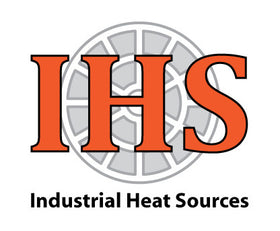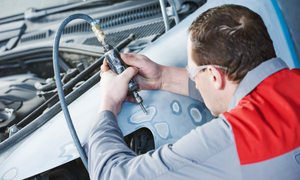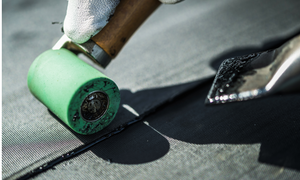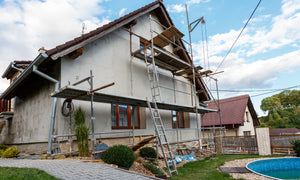5 Plastic Fabrication Finishing Processes and How to Expertly Perform Them

Plastic fabrication is a widely used manufacturing process that involves the creation of plastic products using various techniques and tools.
Once the plastic product has been manufactured, however, your work isn’t done. Plastic fabrication finishing processes are essential for enhancing your product’s visual appeal and functionality. Below, we detail five of the most common plastic fabrication finishing processes and how you can expertly perform them.
>>Related read: 10 Tips for Successfully Welding Plastics
1. Sanding and Polishing
Sanding and polishing are among the most common finishing processes in plastic fabrication. These techniques are used to remove any rough edges, scratches, and blemishes on the surface of the plastic product. Sanding is completed using sandpaper, while polishing is executed with a polishing compound. Products that may need to undergo these processes can include automotive parts like bumpers and grills, medical devices, and furniture, among many others.
To expertly perform these finishing processes, use the right grit of sandpaper and polishing compound. The grit of the sandpaper you choose will depend on the roughness of your plastic surface. If the surface is rough, you will need to use coarse grit sandpaper, while a fine grit sandpaper will be used for a smooth surface. Similarly, the polishing compound used will depend on the level of shine you require.
Select a suitable grade of wet/dry sandpaper to prevent scratching. Gently sand or scuff the plastic surface using irregular circular motions. This technique will help avoid producing deep scratches. It will also minimize the chance that unwanted scratches within the sanded surface may remain visible after the sanding or scuffing procedure has been completed.
To uniformly sand or scruff your plastic surface, use a flexible sanding sponge, sanding foam block, or sanding pad and paste. This will help support the sanding product (sponge, block, or pad) while allowing the technician to modify the shape of the sanding product’s surface to conform to the surface of the plastic being sanded.
Once the sanding or scuffing processes have been completed, wipe down the sanded surface using a mild detergent and soft cloth. It may be necessary to repeat the sanding process several times by gradually using a finer grade or grit of sanding product until the plastic surface is deemed to be satisfactory for polishing.
When polishing plastics, it is important to be sure the surface of the area to be polished is thoroughly cleaned and dried. As with sanding or scuffing, a mild detergent and soft cloth is usually recommended. It is also important to identify the type of plastic that is to be polished and buffed. Once you have identified the type of plastic, then you can research the recommended polishing products for your particular type of plastic material.
2. Painting
Painting is another common finishing process used in plastic fabrication. It is used to add color, texture, and visual appeal to the plastic product. The most common types of paints used in plastic fabrication are enamel, acrylic, and polyurethane. Items that are typically painted following the plastic fabrication process can include automotive parts, home-office furniture and decor, or industrial fixtures.
Before painting, clean and dry the surface of the product. Next, use a paint primer so the paint effectively adheres to the plastic surface. Following, it's key to choose the right type of paint, apply it in thin layers, and use of a hot air hand tool such as the Steinel Rechargeable MH5 Mobile Hot Air Tool or an air heater, such as any from the Tutco-Farnam Flow Torch line, to evenly dry your product without drips or uneven surfaces.
If the technician has successfully welded, repaired, and polished the plastic part, then the correct type of plastic material has already been identified. However, if the technician does not know the type of plastic material being painted, then it is important to identify which type of plastic has been used to make the part. Once the correct type of plastic material has been determined, then the technician can identify what the proper painting procedure should be for their application.
Many of the same techniques used in painting other types of materials are used for painting plastics. However, special procedures and precautions are used when painting plastic to ensure a long-lasting, quality finish. For example, almost every automotive or paint manufacturer provides special instructions. These instructions differ for finishing new unprimed plastics, as well repaired plastic parts and assemblies. Therefore, the technician must determine what the correct priming and painting procedure would be for the plastic part or assembly being repaired and refinished.
3. Printing
Many plastic fabrication products also require graphics, logos, and other designs be added to them. The most common printing techniques used in plastic fabrication are screen printing, pad printing, and digital printing. This process is often seen in the packaging process for the food and beverage and medical and pharmaceutical industries, where safety seals and labels are crucial for keeping consumers safe.
As you prepare, you will need to create a design that is compatible with the printing technique you choose, as well as the size and type of your plastic material. Choosing the right type of plastic for your application is critical. There are many different types of plastics available, and each one has its own unique properties. You’ll need to consider the durability of the plastic, thickness, and printability before you make your final decision.
There are a variety of plastics that can be used for plastic printing. Some of the most popular choices are polycarbonate (PC), polyethylene terephthalate (PETG), polypropylene (PP), polystyrene (PS), and polyvinyl chloride (PVC). Each of these materials has its own advantages and disadvantages, so it is important to select the best type of plastic material for your application.
Print usage applications for each type of plastic include:
- PC: Compact discs, safety helmets, baby feeding bottles, car headlamp lenses, etc.
- PETG: Food & drink containers, food storage containers, retail stands and displays, medical and pharmaceutical products, etc.
- PP: Bumpers, instrument panels, interior elements, door trims, batteries, etc.
- PS: Yogurt containers, Petri dishes, test tubes, smoke detector housings, lighting fixtures, etc.
- PVC: Indoor signage, outdoor signage, credit cards, sporting equipment, bags and luggage, etc.
Once the correct type of plastic has been chosen for your application, then you will need to prepare the surface for printing. The plastic surface must be clean and dry so the print design adheres properly. Additionally, you need to choose an ink that’s compatible with your plastic product to avoid any costly smudging or bleeding. It is also key to use high-quality printer inks to ensure your printed products are vivid and dynamic.
>>Related read: 6 Hot Air Tools That Save Time and Money in the Packaging Process
4. Welding
Welding is used in the plastic fabrication process to join plastic parts together. It is used to create a seamless finish and ensure that the final product is strong and durable. Three common handheld welding methods used in the plastic fabrication process are hot gas welding (hot air welding), extruded-bead seal welding (extrusion welding), and overlap welding.
The four main welding parameters for the hot air welding process are temperature, pressure, welding speed, and positioning of the hot air tool. To ensure a successful weld is created, it is crucial that the technician has a good understanding of these parameters so they can be applied correctly during the welding operation.
Of these parameters, the welding temperature is the most important. The welding temperature is not only controlled by the temperature setting of the hot air tool, but also by the welding speed. The welding speed is the amount of distance or travel the hot air tool is moving within a given time frame (feet/min., meters/min., etc.). Therefore, the faster the desired welding speed, the higher the temperature setting you will need to weld a consistent and uniform welded seam.
Before executing your weld, you will need to determine the proper welding technique and tool, both of which can depend on the type of plastic material used. Make sure your plastic parts are clean and that the surrounding environment is free of dust and debris, as any contamination could weaken your weld.
Some plastics are manufactured with a protective film or coating. Make sure to check manufacturer specifications to be sure that any protective film is removed from the surface before welding. Once the film has been removed, then a beveler scraper can be used to eliminate the surface layer of the material in the vicinity of the weld. When selecting the materials for welding, check that the rod and substrate materials are the same type of plastic polymer (HDPE, LDPE, PP, PVC, etc.).
Also remember that if the prepared substrate is not welded the same day, then you’ll need to repeat the substrate preparation phase again. It is very likely an oxidized coating will form on unprotected plastic welding rod and plastic substrates, which can cause surface contamination, resulting in an inadequate or defective welded seam.
Hot Air Speed Welding
The speed welding technique uses a lightweight handheld hot air tool with specially designed speed welding tips/nozzles. The hot air is usually generated by a hot air tool, such as the IHS Type 1600 Hot Air Tool, or the Ritmo Stylo Flow-Line Hot Air Tool. Combined with heated speed welding nozzles, these tools soften-melt the welding rod and the two plastic parts being welded together.
A plastic welding rod is also referred to as filler rod. The welding rod or filler rod will fill the seam with melted plastic during the welding process. After the hot air tool has reached the desired temperature, the welding rod is inserted into the specially designed speed welding nozzle. While inserting the welding rod, apply slight downward pressure to feed it through the speed welding nozzle. The welding rod is then softened-melted by the hot air flow generated by the hot air tool. A molecular bond is then formed when the welding rod and two substrates begin to cool.
The most common types of welded seams include V-welds, X-welds, corner welds, fillet welds, and film or overlap welds. These welded seams are fabricated with round and triangular speed welding nozzles. These nozzles are available in various shapes and sizes to accommodate the different shapes and sizes of welding rod. Next, be sure to use a tacking nozzle before starting your weld, which will help ensure the parts are tightly secured. Finally, depending on your application, use a seam roller to create a uniform weld.
Depending on the size of the job, a smaller hot air tool may not be feasible. For example, for larger flooring applications, an automatic welding machine such as the Forsthoff F Automatic Floor Welding Machine might be a better fit for the application.
The hot air speed welding technique is often used to fabricate thermoplastic parts, fixtures, and assemblies for vehicles (aircraft, automotive, watercraft), hydro and chemical containment, civil engineering, Schedule 40 and 80 plumbing systems, flooring, and home and office décor.
Hot Air Extrusion Welding
The extrusion welding technique uses a hot air tool designed with specially designed welding shoes. Similar to hot air speed welding, hot air is generated by an extrusion unit, such as the Ritmo Stargun Uno or Ritmo Stargun Link 20. However, unlike hot air speed welding, the handheld extruder pulls the welding rod/filler rod into a heated chamber by use of a screw or worm gear, which in turn pushes the softened-melted welding rod through a welding shoe. Hot air is also generated through an external airflow nozzle, which softens-melts the welding rod and the two plastic parts that are being welded together. A molecular bond is then formed when the welding rod and two substrates begin to cool.
Like hot air speed welding, the most common types of welded seams are the V-welds, X-welds, corner welds, fillet welds, and film or overlap welds. However, unlike hot air speed welding, the welded seams are fabricated with specially designed V-seam, X-seam, corner seam, and overlap seam welding shoes. These welding shoes are also available in various shapes and sizes to accommodate different shapes and thicknesses of welding rods and plastic substrates (sheets).
The hot air extrusion welding technique is often used to fabricate thermoplastic parts, fixtures, and assemblies for vehicles (aircraft, automotive, watercraft), hydro and chemical containment systems, civil engineering (bridge and tunnel construction and landfill), Schedule 40 & 80 plumbing systems, and manufacturing (food and beverage and medical and pharmaceutical) industries, as well.

Hot Air Overlap Welding
The overlap welding technique uses a lightweight handheld hot air tool with specially designed flat wide slot nozzles. The hot air is usually generated by a hot air tool, such as the Forsthoff Hot Air-SE or Forsthoff Oval Q. These tool, combined with the heated wide slot nozzles, act together to soften-melt two separate layers of coated thermoplastic membranes (sheets). The nozzle is placed between the two membranes, heating the membranes simultaneously.
Holding the hot air tool in one hand, and a specially designed roller in the other, the technician will heat both layers of membrane, while moving the hot air tool along the outer edges of the membranes. Both heated membranes are then pressed together with the roller to form a welded seam.
Thermoplastic membranes are available in many sizes, thicknesses, and weights. For example, for applications like signage and billboarding, awnings and truck covers, automotive and boat tarps, technicians may use 10-ounce, 13-ounce, 15-ounce, 20-ounce or 22-ounce materials for coated webbing, fabrics, or thicker reinforced membranes. For some of these applications, thicker, non-reinforced membranes such as block-out materials are used. Thicker, heavier materials that are .030 inches, .040 inches, .060 inches, or .080 inches are also used for roofing, swimming pool liners, and pond liners.
Depending on the size of the job, a smaller hot air tool may not be feasible. For example, for larger banners, tarps, and awnings, an automatic welding machine such as the Forsthoff P2 Overlap Welding Machine or Forsthoff P2 Tape Welding Machine might be a better fit for the job. Or, for roofing, swimming pool liners, and pond liners, the Forsthoff P2 Roof Welding Machine or Forsthoff D Automatic Overlap Machine might be a better fit.
The hot air overlap technique is often used to fabricate thermoplastic membranes and sheets used in automotive and maritime, signage and bill boarding, civil engineering, construction, and roofing applications and industries.
>>Related read: 10 Plastic Welding Accessories That Can Instantly Improve Your Efficiency
5. Coating
Hot air and infrared heaters can also be used to dry and cure the coatings of your product to protect its surface from scratches, abrasions, and UV damage. The most common types of coatings used in plastic fabrication are clear coat, UV coating, and powder coating.
In order to perform the coating process, your plastic surface must be clean and dry, and you need to select the right type of coating depending on the level of protection required, environmental conditions, and heat exposure. Similar to the painting process, the coating must also be applied evenly to avoid any drips or uneven surfaces.
Clear Coating
Heated air movement can be an efficient way to complete the clear coat drying and curing process. Heated air can help create an evaporation effect, reducing humidity in a paint booth and dispersing the remaining moisture from a part’s surface, which expedites the drying process.
Depending on manufacturer recommendations, the primary goal is to uniformly increase the surface temperature of the part, both horizontally and vertically. This helps create the best drying and curing environment for the most efficient results. Several hot air tools, such as the Ritmo HD-Pro Flow-Line Hot Air Tool and Steinel HG 5000 E Hot Air Tool, can be used to complete this process.
UV Coating
The use of infrared heater technology can be an efficient way to adjust the heater to the process. Infrared emitters provide thermal energy, which is converted into heat energy at a precise wavelength, which is then converted into heat energy that is best absorbed within the material. Emitters can be designed or selected to conform to the contours of the product. This provides precise amounts of heat for areas that are to be heated. Infrared heaters can also be precisely shaped to follow the contours of the product where just very small areas need to be heated. Heat is transferred without contact at a high power in seconds. Several infrared emitters, such as the Tempco RPB Medium Wave Infrared Panel and Tempco RPM Metal Face Infrared Panel, can be used to complete this process.
Powder Coating
To guarantee finish quality, you must obtain accurate and specific knowledge about the temperatures that have been used and documented for the coated product throughout the curing process. Each coating has a specific cure schedule provided by the coating manufacturer. This includes process times and temperature values. This information will be invaluable in determining which method of curing will be suitable for your process application.
It is also important to explore the differences between convection ovens (hot air) and infrared ovens. There are advantages and disadvantages to both curing methods. Some of these include lower energy consumption vs. startup costs, limitations with regard to part shape, coating limitations, part surface area temperature elevation, and maintenance costs. Again, you’ll need to have accurate and specific knowledge about the materials and coatings being used for the process application. Several hot air tools, such as the IHS Type 5000 and Type 10000 Air Heaters, or the Tempco RPG High-Temperature Infrared Panel and Tempco RPW High-Temperature Infrared Panel, can be used to complete this process.
Find The Right Plastic Fabrication Tools For Your Needs
While the finishing process is important, your product is only as powerful as your plastic fabrication process. Contact us today for expert, personal advice on which tools will best suit your industrial applications.
- Robert Heater







